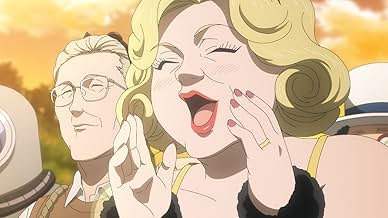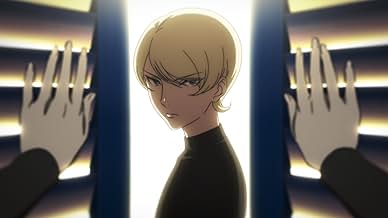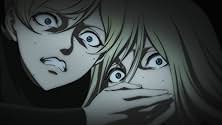PUNTUACIÓN EN IMDb
7,2/10
503
TU PUNTUACIÓN
En esta historia de misterio basada en un manga de Nami Sano, Migi y Dali son dos gemelos idénticos que consiguen ser adoptados por una pareja de ancianos que sólo quería adoptar un niño.En esta historia de misterio basada en un manga de Nami Sano, Migi y Dali son dos gemelos idénticos que consiguen ser adoptados por una pareja de ancianos que sólo quería adoptar un niño.En esta historia de misterio basada en un manga de Nami Sano, Migi y Dali son dos gemelos idénticos que consiguen ser adoptados por una pareja de ancianos que sólo quería adoptar un niño.
- Premios
- 1 nominación en total
Explorar episodios
Argumento
¿Sabías que...?
- CuriosidadesThe series is dedicated to the original manga author Nami Sano, who deceased of cancer two month prior to the series' premiere. The dedication words are shown in the last episode, written in French by character Micchan.
Reseña destacada
In August, 36-year-old mangaka Nami Sano (Author of Migi and Dali) lost her battle with cancer. She was in the background of the pragmatist Sakamoto, a character beloved for his flawless, cool armor. The four-volume manga Sakamoto was serialized from 2011 to 2015, and in 2016 an anime adaptation was released. Sakamoto is still regarded as one of the most well-liked anime of that year and season despite her passing.
Migi & Dali, Nami Sano's last manga series, was postponed until the fall because of a mangaka's mental health problems. She was overcome by the sickness, and she died two months prior to the anime's premiere. For a skilled writer who had dreamed of becoming a mangaka since elementary school, this unexpected loss is devastating.
A child named Hitori is adopted by the villainous Sonoyama family in Origon Village in the 1980s. The family's dishonest behavior leads to a gripping mystery thriller. The Sonoyamas take great care of their adoptive kid, who they insist is beautiful and has a sweet soul. The son, however, is a masquerade with the intention of finding and solving the Unsolved Mysteries case; he is more than simply a façade.
The 13-year-old twin brothers Hitori, who share the same appearance but differ in blood-related characteristics, are the focus of the series. Dali is logical and cunning, but Migi is sensitive and kind. The absurd comedy by Nami Sano examines the Sonoyamas' pleasure in their adoptive kid without realizing that they look alike. Driven by their thirst for retribution, the two intelligence-driven brothers set out to explore Origon Village and track down the people responsible for an extraordinary tale.
The intriguing tale of Migi & Dali has ludicrous characters, such as the twin brothers Migi and Dali, as well as other well-known figures like the Ichijo family, Shunpei Akiyama, Maruta Tsutsumi, and Micchan. Character development is not squandered nor used as a cliché in this intricate and interwoven tale; in fact, the more characters there are in Origon Village, the more surprising the revelations become.
The self-contained manga by Nami Sano is painstakingly detailed and written; it has 44 chapters spread across 7 volumes. The anime, which spans the whole manga in 13 episodes and was directed by Mankyuu, is his largest project to date. The anime's overall execution is commended for its meticulous handling of story aspects and precise pacing. Koori Zokusei Danshi and Cool na Douryou Joshi are the show's directors.
The one criticism of the anime, meanwhile, is that it was made by Geek Toys and CompTown, a small animation production company. Although its main feature was meant to be gritty and dark, it doesn't look the prettiest. In this regard, the manga was superior to the anime, which attempted to look like a literal carbon copy of the original work while making very few changes to preserve the uncomfortable aspects of its surreal comedy. I'll give you that; it's a respectable effort.
One of the anime's greatest features is the music. Even while Utaite Soraru and Rib's OP song sounds amazing, its images emphasize how unsettling the twin brothers' unique personalities-which yet somehow make them one and the same-make them while portraying the titular Hitori. The use of manga-style panels in Nulbarich's ED song, which depicts the twin brothers growing up alone without a parental figure while hoping for a bright light of hope that will break them out of their rut, creates a constant riot of melancholy and hope. The deliberate execution of each song's graphics is evident in their entirety, and contributes to the anime's flawless quality.
Even though this is undoubtedly the last work of visual literature that Nami Sano will produce, let it be the one that elevates her profile and brings her the acknowledgment that she so richly deserves. Sakamoto desu ga? Could be equally famous, but Migi & Dali is the highly regarded product of some of the most insanely gripping and audaciously brave stories to be published in a very long time.
We would like to express our sincere gratitude to Director Mankyuu and his team for presenting the late Nami Sano's final vision on the small screen. And may the late mangaka be honored for her exceptional talent and work.
We appreciate you for your efforts to the AniManga business and wish you rest in peace, Nami Sano.
Migi & Dali, Nami Sano's last manga series, was postponed until the fall because of a mangaka's mental health problems. She was overcome by the sickness, and she died two months prior to the anime's premiere. For a skilled writer who had dreamed of becoming a mangaka since elementary school, this unexpected loss is devastating.
A child named Hitori is adopted by the villainous Sonoyama family in Origon Village in the 1980s. The family's dishonest behavior leads to a gripping mystery thriller. The Sonoyamas take great care of their adoptive kid, who they insist is beautiful and has a sweet soul. The son, however, is a masquerade with the intention of finding and solving the Unsolved Mysteries case; he is more than simply a façade.
The 13-year-old twin brothers Hitori, who share the same appearance but differ in blood-related characteristics, are the focus of the series. Dali is logical and cunning, but Migi is sensitive and kind. The absurd comedy by Nami Sano examines the Sonoyamas' pleasure in their adoptive kid without realizing that they look alike. Driven by their thirst for retribution, the two intelligence-driven brothers set out to explore Origon Village and track down the people responsible for an extraordinary tale.
The intriguing tale of Migi & Dali has ludicrous characters, such as the twin brothers Migi and Dali, as well as other well-known figures like the Ichijo family, Shunpei Akiyama, Maruta Tsutsumi, and Micchan. Character development is not squandered nor used as a cliché in this intricate and interwoven tale; in fact, the more characters there are in Origon Village, the more surprising the revelations become.
The self-contained manga by Nami Sano is painstakingly detailed and written; it has 44 chapters spread across 7 volumes. The anime, which spans the whole manga in 13 episodes and was directed by Mankyuu, is his largest project to date. The anime's overall execution is commended for its meticulous handling of story aspects and precise pacing. Koori Zokusei Danshi and Cool na Douryou Joshi are the show's directors.
The one criticism of the anime, meanwhile, is that it was made by Geek Toys and CompTown, a small animation production company. Although its main feature was meant to be gritty and dark, it doesn't look the prettiest. In this regard, the manga was superior to the anime, which attempted to look like a literal carbon copy of the original work while making very few changes to preserve the uncomfortable aspects of its surreal comedy. I'll give you that; it's a respectable effort.
One of the anime's greatest features is the music. Even while Utaite Soraru and Rib's OP song sounds amazing, its images emphasize how unsettling the twin brothers' unique personalities-which yet somehow make them one and the same-make them while portraying the titular Hitori. The use of manga-style panels in Nulbarich's ED song, which depicts the twin brothers growing up alone without a parental figure while hoping for a bright light of hope that will break them out of their rut, creates a constant riot of melancholy and hope. The deliberate execution of each song's graphics is evident in their entirety, and contributes to the anime's flawless quality.
Even though this is undoubtedly the last work of visual literature that Nami Sano will produce, let it be the one that elevates her profile and brings her the acknowledgment that she so richly deserves. Sakamoto desu ga? Could be equally famous, but Migi & Dali is the highly regarded product of some of the most insanely gripping and audaciously brave stories to be published in a very long time.
We would like to express our sincere gratitude to Director Mankyuu and his team for presenting the late Nami Sano's final vision on the small screen. And may the late mangaka be honored for her exceptional talent and work.
We appreciate you for your efforts to the AniManga business and wish you rest in peace, Nami Sano.
- Mysterygeneration
- 13 ene 2024
- Enlace permanente
Selecciones populares
Inicia sesión para calificar y añadir a tu lista para recibir recomendaciones personalizadas
Detalles
- Duración24 minutos
- Color
Contribuir a esta página
Sugerir un cambio o añadir el contenido que falta

Principal laguna de datos
By what name was Migi & Dali (2023) officially released in India in English?
Responde
![Ver Trailer Season 1 [OV]](https://m.media-amazon.com/images/M/MV5BOGFhYzU2MzctNjM2YS00MGUwLWE2ODMtMzY1MzhkMTZhNDg3XkEyXkFqcGdeQXRyYW5zY29kZS13b3JrZmxvdw@@._V1_QL75_UX500_CR0)




















